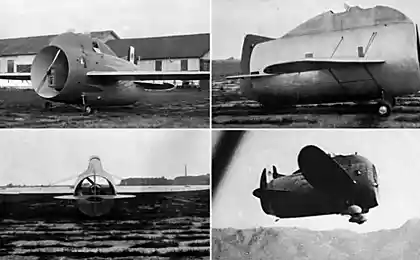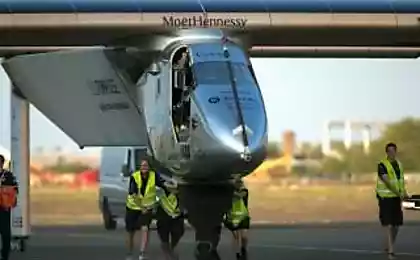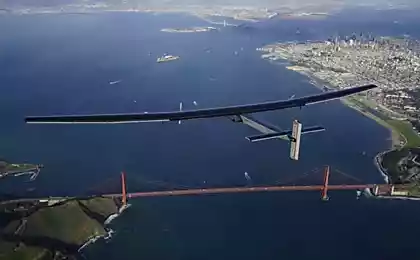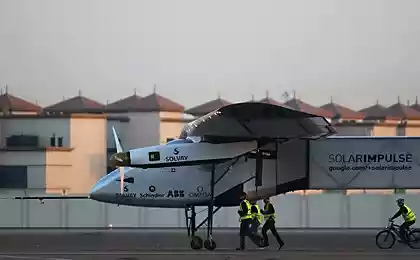558
Solar impulse: is it possible to circumnavigate the world by plane without fuel
Projects Solar Impulse and ABB in 2014 launched a world tour of the historic aircraft that runs entirely on solar energy. The creators hope to inspire future generations with the problems of energy consumption and fuel.

Now the plane is in the way, they run in shifts pilots Bertrand Piccard and Andre Borschberg, on Board help them three engineers ABB.We talked to the pilots and asked them how the journey time required to fly around the world and whether you can live off of solar energy.
— Why did you decide to make a flight?
Bertrand Piccard: After his first circumnavigation in a balloon I knew I had to find a way around the globe without depending on fuel resources. I teamed up with my friend andré Borschberg, an entrepreneur and an engineer to create Solar Impulse ― a plane capable of day and night to fly without fuel and comes in motion only by solar energy. What we're doing with Solar Impulse, perfectly demonstrates the efficiency of technologies that allow us to save energy and use renewable types.
Andre Borschberg: We work on technology and at the same time, it's actually an interesting gamble for a person. But the most important thing for us is to inspire future generations. When I see children and students that come in looking their radiant eyes on this plane, I understand that this is the reward for work, we spent 12 years.
— Describe the technical characteristics of the aircraft. As it will recharge your batteries?
André borschberg: the Plane absorbs all the needed energy from solar cells. These cells turn sunlight into electricity to simultaneously give power to the motor and to recharge the batteries so that the plane could fly all night. Thus, the aircraft can fly day and night without fuel, thus making the idea of infinite flight more realistic — although in bad weather we, of course, have to go to the landing.
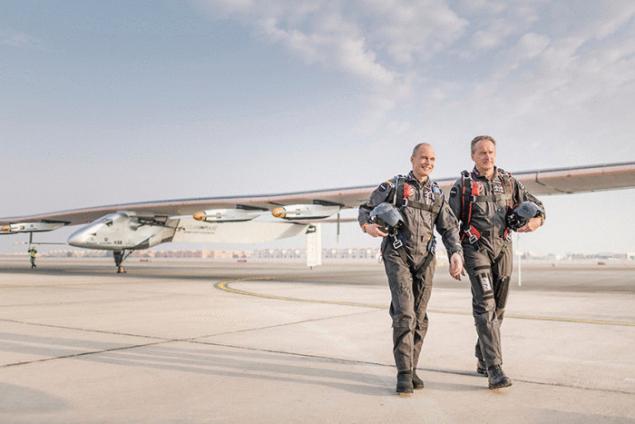
André borschberg and Bertrand Piccard, © Solar Impulse| Ackermann | Reva
The maximum rate at which can fly a plane — 90.7 km / h In the air, the speed depends on dominant winds. From the point of view of the capabilities of the aircraft, we had to choose between duration and speed, we chose a duration. The flight can be continued, because we don't need to refuel. The aircraft can stay in the air all the time, but of course, the pilot is not so hardy.
Solar panels located on the wings, fuselage and horizontal stabilizer of the aircraft. They provide the optimal balance between lightness, flexibility and efficiency; the solar panel is 1 meter in width, they are separated by spaces and are supported by a flexible structure, so they seem to "float" on the solid parts of the wing structure. The energy collected by solar panels is stored in four 70-liter lithium-polymer batteries, their energy density is optimized to 260 WH / kg, Their total mass amounts to 633 kg, or more than a quarter of the total weight of the aircraft.
The amount of energy collected is relatively modest, and we still need to conduct some research in order to reduce its consumption. Therefore, the project is mainly a demonstration of conservation of energy, which can be achieved using currently available technologies.
— You have already made a flight across the US on the previous version of the aircraft. Were there any difficulties during the flight?
André borschberg: the Mission was harder than we anticipated, especially because of the difficult weather conditions, but we sought to solve any problems. Landing at the airport in Dallas was extremely difficult due to strong winds and, of course, the last flight was hard because of the holes in the lower part of the left wing. Nevertheless, it proves the strength of the aircraft, because he eventually stood the wind even with a faulty wing.
— Tell us about your daily life in aircraft.
Andre Borschberg: in addition to the duties of piloting my schedule has things like rest, food and exercise. Besides, I'm always connected to the mission control Center via satellite communication to follow the instructions of the pilot. I can also communicate with the media and the public through the app on the iPad, such as Twitter.

construction of Solar Impulse Abb, © AP / East News
We can't sleep when flying over populated areas, so we have developed methods to stay awake. Bertrand uses methods of self-hypnosis, and I do yoga. Over the oceans can take a short NAP, but a maximum of 20 minutes as the plane at this time is flying on autopilot.
— As you need time to fly around the world?
André borschberg: a round trip is the path 35 000 kilometers. Although the flight and carried out four hands, Bertrand and I have accumulated nearly 500 flight hours over 5 months in a tiny cockpit of Solar Impulse 2. The plane needs good weather to fly. Meteorologists analyze weather forecast to find the appropriate time and favourable route for the flight, and air traffic controllers coordinate the flight path with the regional control centres, mathematicians are calculating the flight parameters with consideration of meteorological data, as well as the amount of sunlight and air to movement restrictions.
In the future solar panels will play a big role in aviation?
Andre Borschberg: Solar drones can be used as telecommunications platforms, it's cheaper satellites. We will soon see local aircraft on solar energy. We can't say that in near future there will be commercial aircraft of this kind, but we must remember the examples of the past. In 1903, when the Wright brothers successfully flew his plane over a distance of 200 meters, could we imagine that after 24 years Lindbergh would cross the Atlantic ocean? He was alone on Board, and 30 years later the aircraft was carrying 200 passengers, making the same journey in 8 hours, with two people in that time walked on the moon!
— What is the main thing in the project ― to make a revolution in the field of clean technologies or to change people's attitudes to energy consumption?
Bertrand Piccard: We want to show that we can achieve incredible things with renewable energies and clean technologies and to inspire more people to use these technologies in their lives to reduce the amount of energy consumed in the world and CO2 emissions. Today this is possible thanks to the same type of technology in Solar Impulse. Everyone is talking about climate change in terms of a huge problem. We want to say that climate change is a fantastic opportunity for new solutions, new "clean" technologies. We not only protect the environment but also create jobs, benefit industry and open up new markets and support their growth.

© © Solar Impulse | Revillard | Rezo.ch
You can use the same technology that we do. It's not futuristic and not secret technology — it is available to everyone: the same solar panels, the same led lights, same materials, same IT programs. You can also use it in daily life for cars, houses, systems of heating, cooling or lighting. This plane shows that anything is possible from the point of view of energy efficiency, aerodynamic characteristics, lightness and strength of materials. We use materials that can be used in all homes and household appliances.published
P. S. And remember, only by changing their consumption — together we change the world! ©
Source: theoryandpractice.ru

Now the plane is in the way, they run in shifts pilots Bertrand Piccard and Andre Borschberg, on Board help them three engineers ABB.We talked to the pilots and asked them how the journey time required to fly around the world and whether you can live off of solar energy.
— Why did you decide to make a flight?
Bertrand Piccard: After his first circumnavigation in a balloon I knew I had to find a way around the globe without depending on fuel resources. I teamed up with my friend andré Borschberg, an entrepreneur and an engineer to create Solar Impulse ― a plane capable of day and night to fly without fuel and comes in motion only by solar energy. What we're doing with Solar Impulse, perfectly demonstrates the efficiency of technologies that allow us to save energy and use renewable types.
Andre Borschberg: We work on technology and at the same time, it's actually an interesting gamble for a person. But the most important thing for us is to inspire future generations. When I see children and students that come in looking their radiant eyes on this plane, I understand that this is the reward for work, we spent 12 years.
— Describe the technical characteristics of the aircraft. As it will recharge your batteries?
André borschberg: the Plane absorbs all the needed energy from solar cells. These cells turn sunlight into electricity to simultaneously give power to the motor and to recharge the batteries so that the plane could fly all night. Thus, the aircraft can fly day and night without fuel, thus making the idea of infinite flight more realistic — although in bad weather we, of course, have to go to the landing.

André borschberg and Bertrand Piccard, © Solar Impulse| Ackermann | Reva
The maximum rate at which can fly a plane — 90.7 km / h In the air, the speed depends on dominant winds. From the point of view of the capabilities of the aircraft, we had to choose between duration and speed, we chose a duration. The flight can be continued, because we don't need to refuel. The aircraft can stay in the air all the time, but of course, the pilot is not so hardy.
Solar panels located on the wings, fuselage and horizontal stabilizer of the aircraft. They provide the optimal balance between lightness, flexibility and efficiency; the solar panel is 1 meter in width, they are separated by spaces and are supported by a flexible structure, so they seem to "float" on the solid parts of the wing structure. The energy collected by solar panels is stored in four 70-liter lithium-polymer batteries, their energy density is optimized to 260 WH / kg, Their total mass amounts to 633 kg, or more than a quarter of the total weight of the aircraft.
The amount of energy collected is relatively modest, and we still need to conduct some research in order to reduce its consumption. Therefore, the project is mainly a demonstration of conservation of energy, which can be achieved using currently available technologies.
— You have already made a flight across the US on the previous version of the aircraft. Were there any difficulties during the flight?
André borschberg: the Mission was harder than we anticipated, especially because of the difficult weather conditions, but we sought to solve any problems. Landing at the airport in Dallas was extremely difficult due to strong winds and, of course, the last flight was hard because of the holes in the lower part of the left wing. Nevertheless, it proves the strength of the aircraft, because he eventually stood the wind even with a faulty wing.
— Tell us about your daily life in aircraft.
Andre Borschberg: in addition to the duties of piloting my schedule has things like rest, food and exercise. Besides, I'm always connected to the mission control Center via satellite communication to follow the instructions of the pilot. I can also communicate with the media and the public through the app on the iPad, such as Twitter.

construction of Solar Impulse Abb, © AP / East News
We can't sleep when flying over populated areas, so we have developed methods to stay awake. Bertrand uses methods of self-hypnosis, and I do yoga. Over the oceans can take a short NAP, but a maximum of 20 minutes as the plane at this time is flying on autopilot.
— As you need time to fly around the world?
André borschberg: a round trip is the path 35 000 kilometers. Although the flight and carried out four hands, Bertrand and I have accumulated nearly 500 flight hours over 5 months in a tiny cockpit of Solar Impulse 2. The plane needs good weather to fly. Meteorologists analyze weather forecast to find the appropriate time and favourable route for the flight, and air traffic controllers coordinate the flight path with the regional control centres, mathematicians are calculating the flight parameters with consideration of meteorological data, as well as the amount of sunlight and air to movement restrictions.
In the future solar panels will play a big role in aviation?
Andre Borschberg: Solar drones can be used as telecommunications platforms, it's cheaper satellites. We will soon see local aircraft on solar energy. We can't say that in near future there will be commercial aircraft of this kind, but we must remember the examples of the past. In 1903, when the Wright brothers successfully flew his plane over a distance of 200 meters, could we imagine that after 24 years Lindbergh would cross the Atlantic ocean? He was alone on Board, and 30 years later the aircraft was carrying 200 passengers, making the same journey in 8 hours, with two people in that time walked on the moon!
— What is the main thing in the project ― to make a revolution in the field of clean technologies or to change people's attitudes to energy consumption?
Bertrand Piccard: We want to show that we can achieve incredible things with renewable energies and clean technologies and to inspire more people to use these technologies in their lives to reduce the amount of energy consumed in the world and CO2 emissions. Today this is possible thanks to the same type of technology in Solar Impulse. Everyone is talking about climate change in terms of a huge problem. We want to say that climate change is a fantastic opportunity for new solutions, new "clean" technologies. We not only protect the environment but also create jobs, benefit industry and open up new markets and support their growth.

© © Solar Impulse | Revillard | Rezo.ch
You can use the same technology that we do. It's not futuristic and not secret technology — it is available to everyone: the same solar panels, the same led lights, same materials, same IT programs. You can also use it in daily life for cars, houses, systems of heating, cooling or lighting. This plane shows that anything is possible from the point of view of energy efficiency, aerodynamic characteristics, lightness and strength of materials. We use materials that can be used in all homes and household appliances.published
P. S. And remember, only by changing their consumption — together we change the world! ©
Source: theoryandpractice.ru


